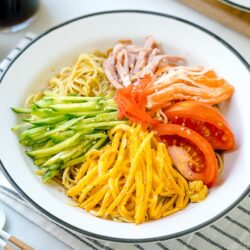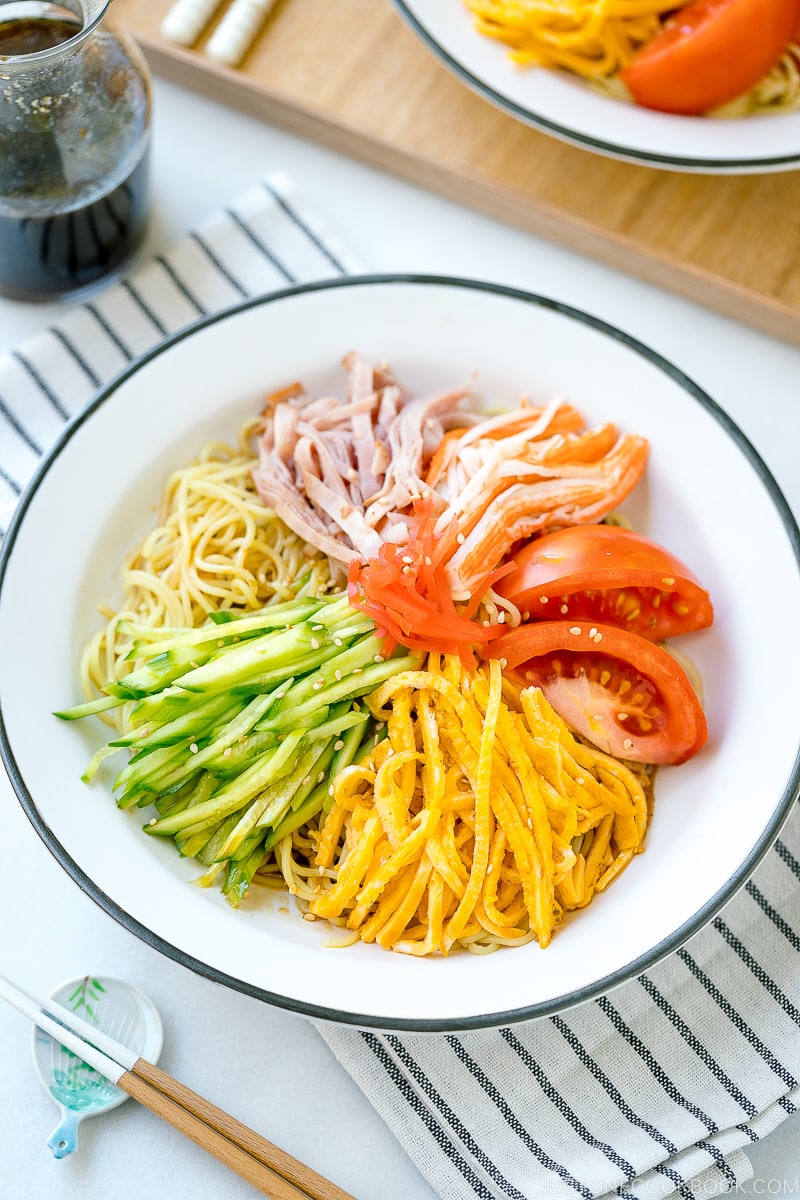
As the temperature and humidity soar in Japan in the late summer, I just want to eat cold noodle dishes like cold soba or cold udon. But when it gets extra hot, all I can think about is the flavorful, rainbow color of toppings on a bowl of cold ramen called Hiyashi Chuka (冷やし中華).
Today, I’m sharing a hiyashi chuka recipe with my favorite homemade soy sauce-based noodle dressing.
What is Hiyashi Chuka?
Hiyashi Chuka (冷やし中華) literally means “Cold Chinese-style”, but in fact it refers to a popular Japanese summer dish of which cold ramen noodles paired with toppings such as strips of thin omelette, cucumber, ham, and imitation (or real) crab. To tie everything together, it’s served with a soy sauce-based dressing that is sweet, savory, nutty, and acidic.
Refreshing and chewy, crisp and crunchy, sweet and savory—there’s plenty of flavors and textures in this cold noodle dish that it’s hard not to fall in love with it!
I also love that it is highly versatile so you can be creative and switch up the toppings as you like.
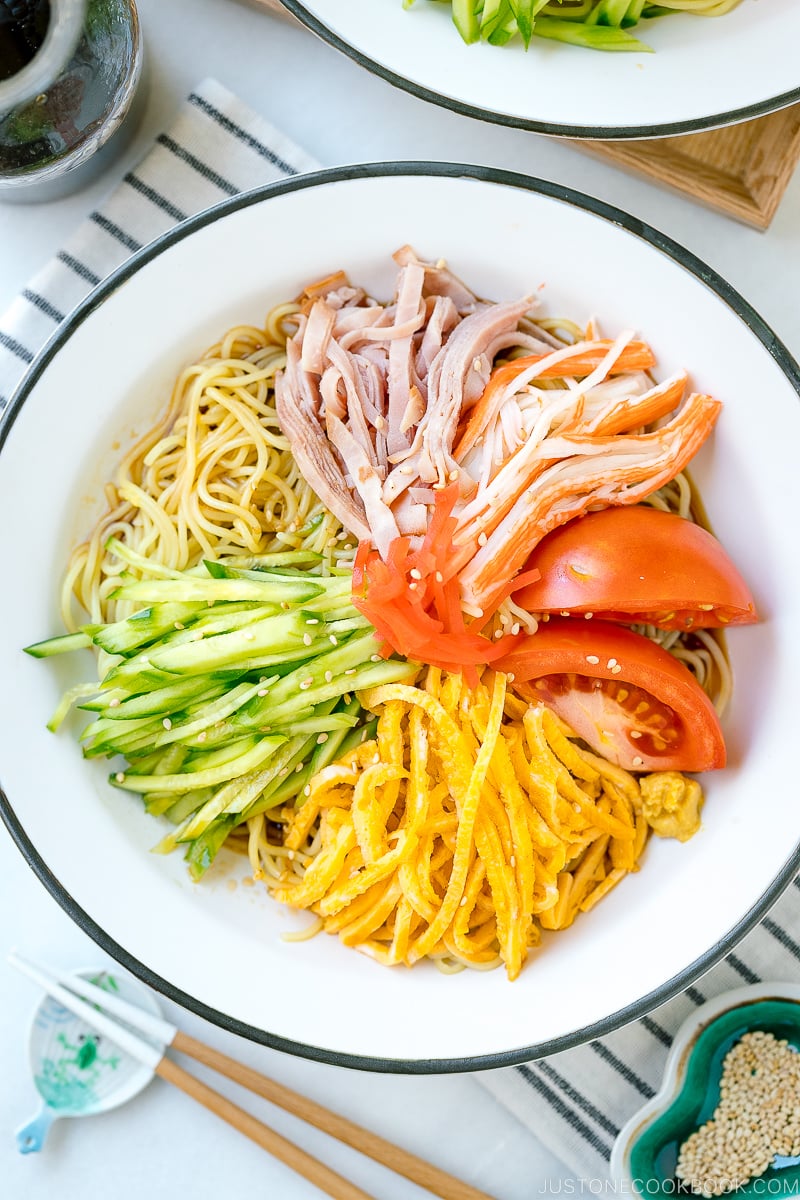
Hiyashi Chuka Topping Ideas
The classic hiyashi chuka consists of ramen noodles, egg, ham, imitation crab, cucumber, and tomatoes. However, there’s always room for customization. Here, I suggest a few variations:
- Avocado
- Blanched bean sprout
- Boiled egg
- Canned tuna
- Chashu
- Cooked shrimp
- Fried firm tofu
- Shredded chicken (rotisserie, boiled)
- Mizuna
- Lettuce
- Shredded nori
- Sautéed mushrooms
Where to Get Hiyashi Chuka Noodles
Japanese and Asian grocery stores carry Hiyashi Chuka (Cold Ramen) noodles in the refrigerated section. You can figure out the package easily as it usually has an image of the classic hiyashi chuka, shown below.
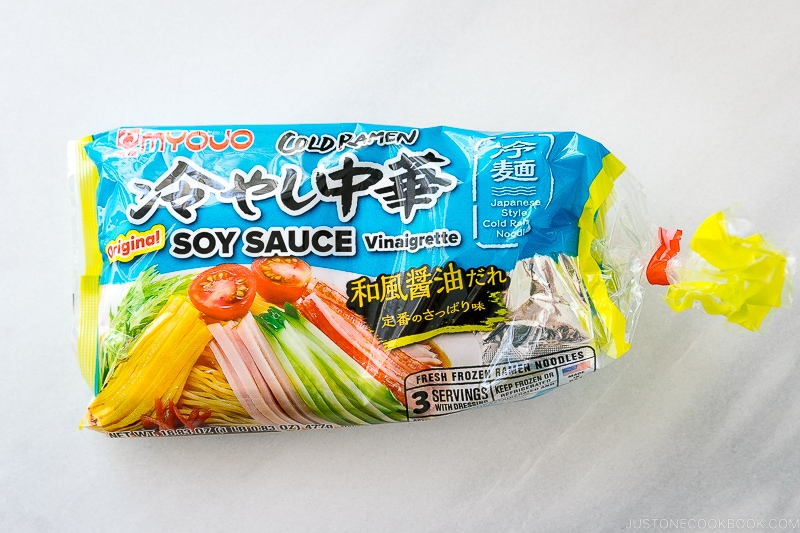
Typically, there are one to two kinds of hiyashi chuka: soy sauce dressing and sesame dressing. I am not a big fan of using the packaged sauce (check the ingredient list before you decide) so I have both dressing recipes on Just One Cookbook. The homemade sauces are healthier and easy to make at home!
- Soy sauce based dressing (see the recipe card below)
- Sesame miso based dressing
Since the noodles are fresh, you probably can’t find them online. In that case, you can try these dried ramen noodles.
Make Vegetarian/Vegan-Friendly Hiyashi Chuka
If you are vegetarian, simply omit ham and imitation crab (and egg, if vegan) and add your favorite veggies or tofu instead.
You can make the dressing by swapping the chicken stock with vegetable broth, kombu dashi, or water.
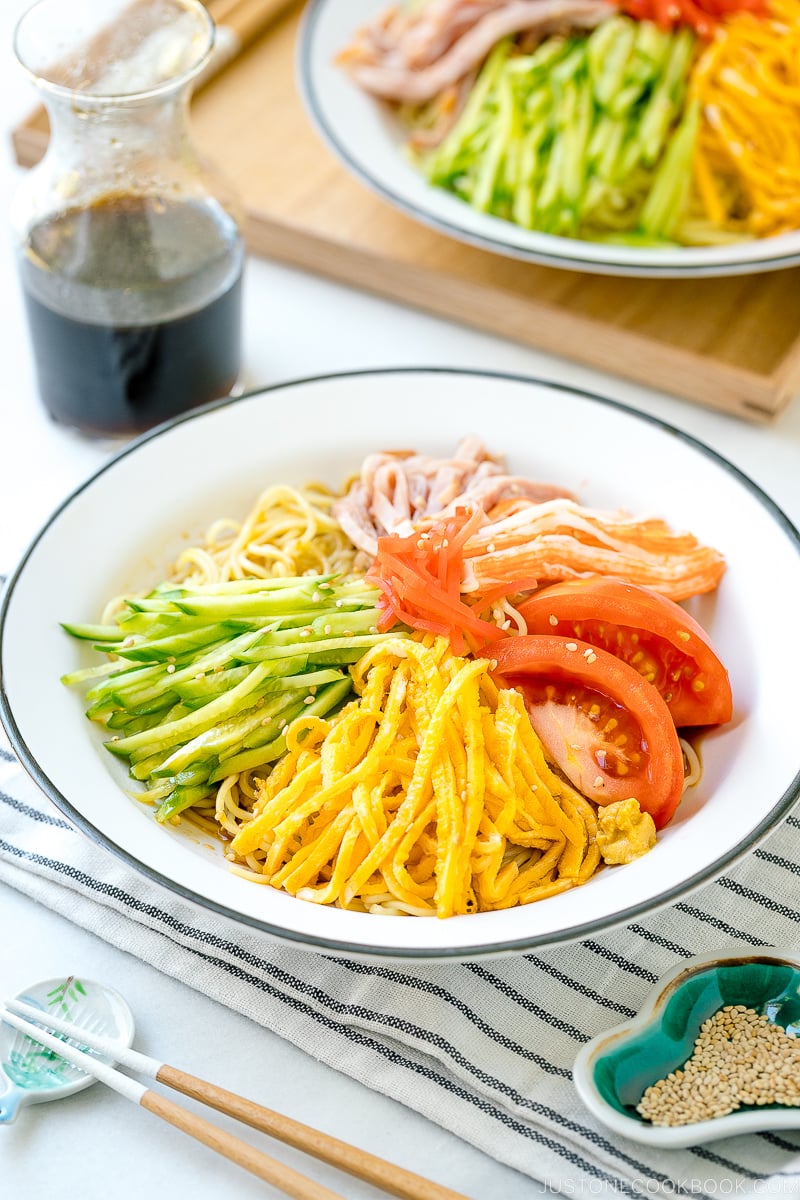
Hiyashi Chuka Cooking Tips
- Start preparing the dressing and omelette, which require cooking and then cooling down.
- Cut the topping ingredients into thin strips or bite-sized—”noodle-thin” strip for most toppings so that you can enjoy them with the noodles in one bite.
- Rinse the noodles under cold running water. It’s important to rinse off the starch for a better texture.
- Keep the toppings, noodles, and dressing chilled for the ultimate cold noodle experience!
- Gradually add the dressing; you don’t have to use it all.
On hot days, a cold noodle dish like hiyashi chuka is a nutritious meal to cool your body down, while filling up your tummy. Now pick up fresh hiyashi chuka noodles from an Asian or Japanese grocery store, prepare your favorite toppings, and create this cool Japanese dish!
More Cold Noodle Recipes to Enjoy
- Hiyashi Chuka with Sesame Miso Sauce
- Tsukemen (Dipping Noodles)
- Oroshi Soba
- Cold Tanuki Udon
- Cold Curry Udon
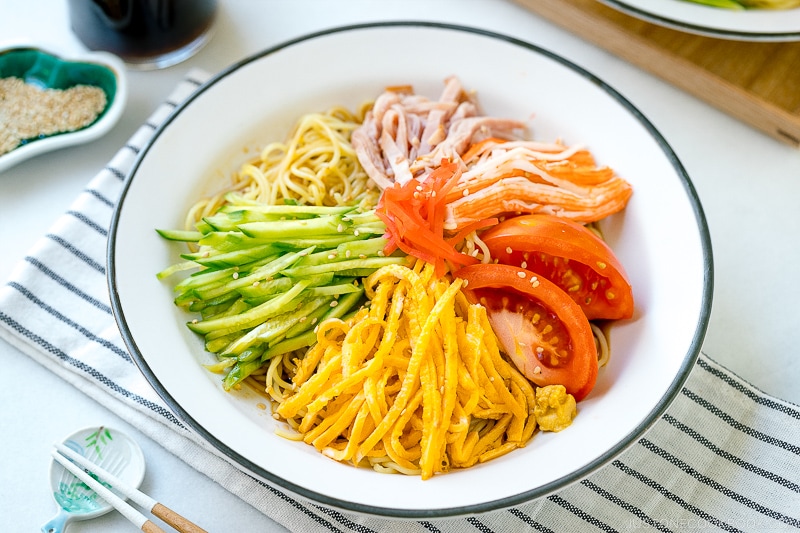
Wish to learn more about Japanese cooking? Sign up for our free newsletter to receive cooking tips & recipe updates! And stay in touch with me on Facebook, Pinterest, YouTube, and Instagram.
Hiyashi Chuka (Cold Ramen)
Ingredients
For the Dressing
- ½ tsp ginger (grated, with juice; from 1-inch, 2.5 cm knob)
- 4 Tbsp soy sauce
- 3 Tbsp rice vinegar (unseasoned)
- 2 Tbsp chicken stock/broth (or substitute water)
- 2 Tbsp water
- 2 Tbsp sugar
- 1 Tbsp toasted sesame oil
- ¼ tsp la-yu (Japanese chili oil) (optional; make my Homemade La-yu)
For the Toppings
- 2 large eggs (50 g each w/o shell) (each thin omelette uses 2 eggs)
- 2 tsp sugar
- ⅛ tsp Diamond Crystal kosher salt
- 1 Tbsp neutral oil (to fry the egg; use 1 Tbsp per omelette)
- 2 Japanese or Persian cucumbers (or use an English cucumber and remove the seeds)
- 1 tomato
- 4 slices ham
- 4 sticks real or imitation crabmeat
For the Noodles
- 3 servings hiyashi chuka noodles (6 oz, 170 g fresh noodles per serving)
For Serving (optional)
Instructions
- Gather all the ingredients.
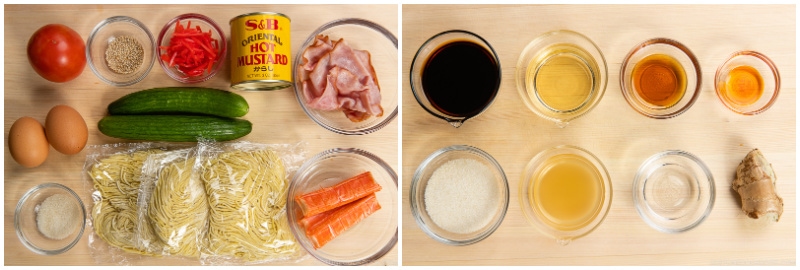
To Make the Dressing
- Peel and grate the ginger (I use a ceramic grater). Measure ½ tsp ginger, grated, with juice. If you like a gingery taste, use 1 tsp. You can always add more after you taste the sauce.
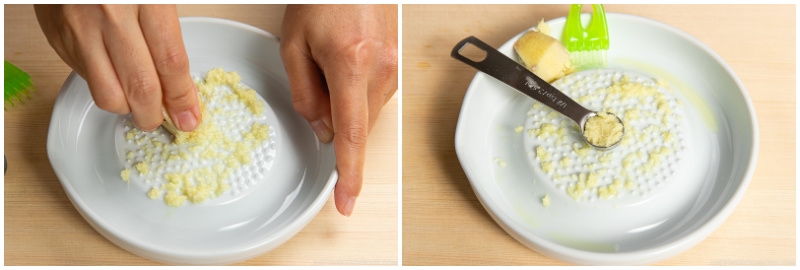
- In a medium saucepan, combine all the dressing ingredients—½ tsp ginger, 4 Tbsp soy sauce, 3 Tbsp rice vinegar (unseasoned), 2 Tbsp chicken stock/broth, 2 Tbsp water, 2 Tbsp sugar, 1 Tbsp toasted sesame oil, and ¼ tsp la-yu (Japanese chili oil). Whisk them all together. Bring it to a simmer and then turn off the heat. Make sure the sugar is completely dissolved.
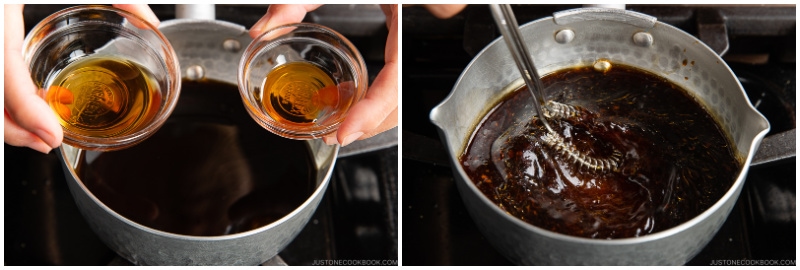
- Prepare a bowl of iced water. Dip the base of the saucepan into the iced water to cool the sauce. Cool it completely, and store it in the refrigerator if you‘re serving later. You can make the dressing ahead and store it in the refrigerator for up to a week.
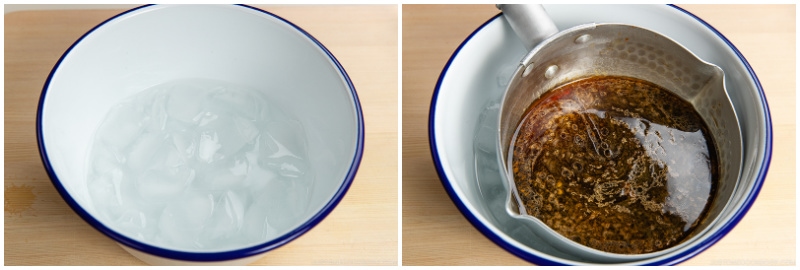
To Prepare the Toppings
- To make a thin omelette, whisk together 2 large eggs (50 g each w/o shell), 2 tsp sugar, and ⅛ tsp Diamond Crystal kosher salt in a small bowl.
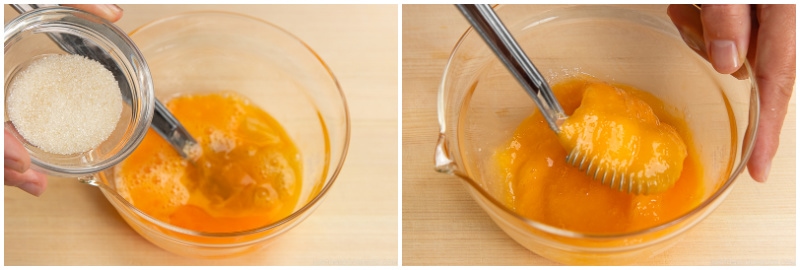
- Heat a large frying pan over medium heat. When the pan is hot, add 1 Tbsp neutral oil and evenly distribute it. Pour the egg mixture into the pan (or if you‘re doubling the recipe, make two omelettes and use two eggs each).
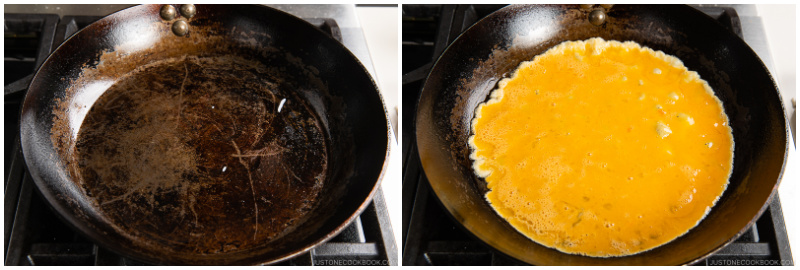
- When the egg is set on the surface, flip and cook the other side for 1–2 minutes. Transfer the omelet to a paper towel to absorb the excess oil and let it cool.
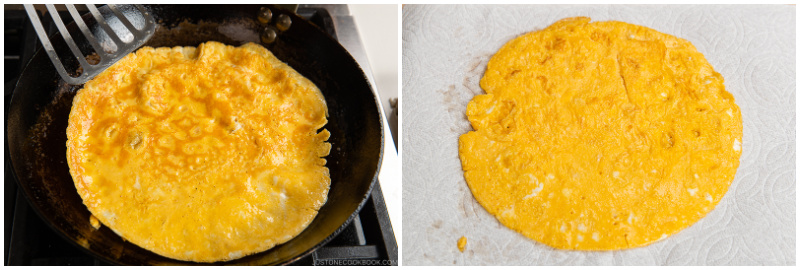
- Peel the skin of 2 Japanese or Persian cucumbers, alternating peeled and unpeeled strips to create a stripe pattern. Diagonally cut the cucumbers into thin slices, and then cut them into julienned strips.
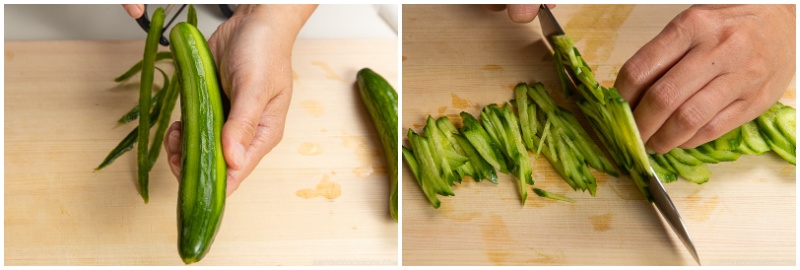
- Cut 1 tomato in half and then cut the halves into wedges.
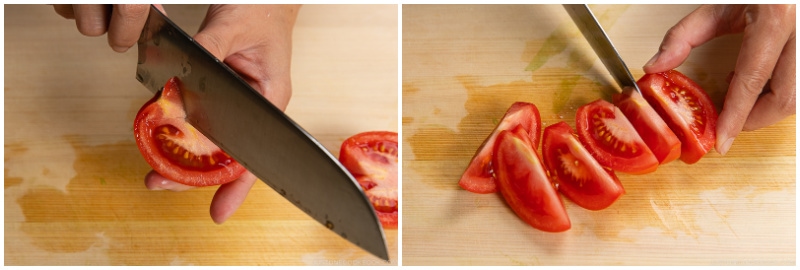
- Cut 4 slices ham into thin julienned strips.
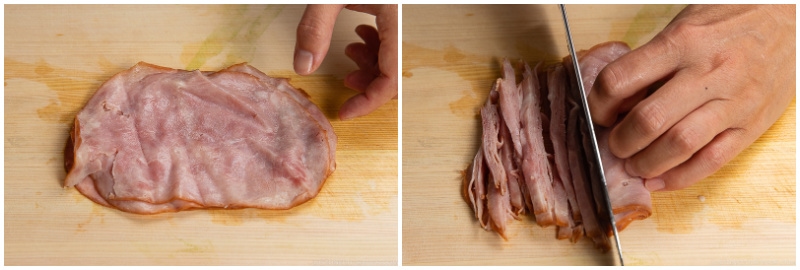
- Separate 4 sticks real or imitation crabmeat into thin strips.
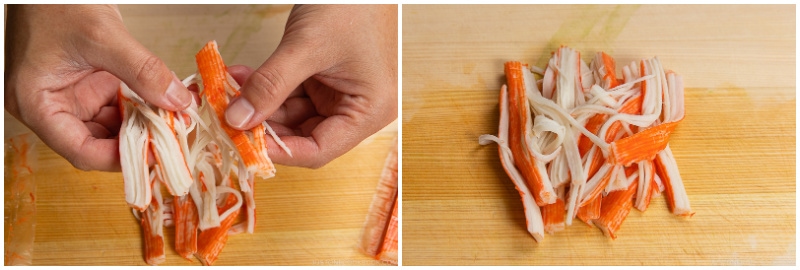
- When the omelette is cool, cut it in half and then into thin strips.

- Now, all the toppings are ready.
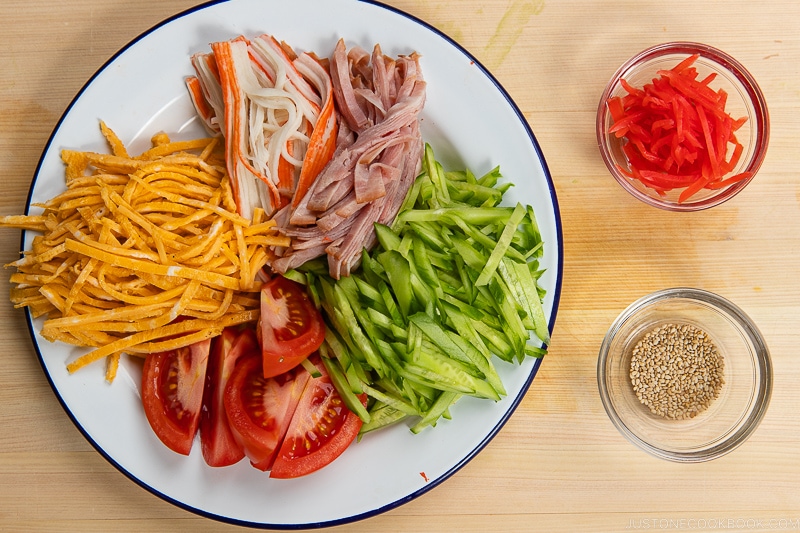
To Cook the Noodles
- Bring a big pot of water to a boil. Loosen and separate 3 servings hiyashi chuka noodles with your hands and add them to the boiling water. Cook the fresh noodles according to the package directions. Tip: I usually cook the noodles for less time for a firm, al dente doneness.
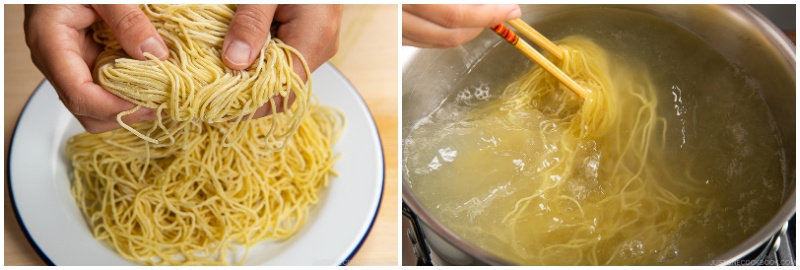
- Transfer the cooked noodles to a colander and rinse them thoroughly with your hands under cold running water. This stops the cooking, cools the noodles, and removes the excess starch. Drain completely, shaking the colander to remove the excess water.
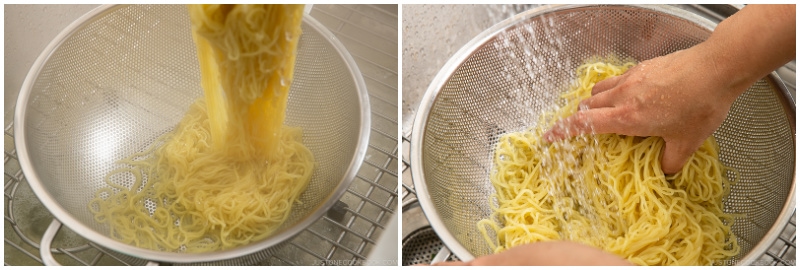
To Assemble and Serve
- Divide the noodles into individual plates or bowls. Place all the toppings and pour the dressing on top before serving. Sprinkle with 1½ tsp toasted white sesame seeds (optional). Serve optional pickled red ginger (beni shoga or kizami beni shoga) on top and Japanese karashi hot mustard on the side, if desired.
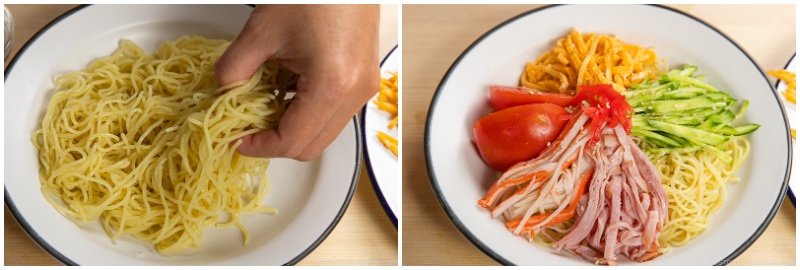
To Store
- You can keep the leftover sauce and toppings in separate airtight containers and store them in the refrigerator for 2 days. I recommend preparing the noodles right before you serve.
Nutrition
Did you make this recipe?
Tag @justonecookbook on Instagram so we can see your delicious creation!
Editor’s Note: The post was originally published on July 7, 2013. The images and blog post have been updated and the recipe is slightly revised on July 17, 2022.


